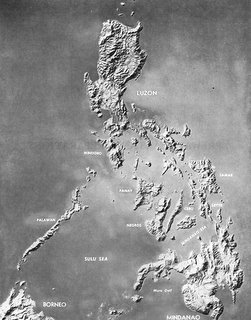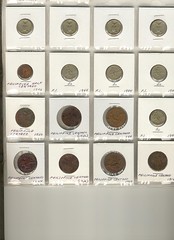
It is with pained effort and sadness that I write the following entry:
Mrs. Gail Ilagan (
gail@mindanews.com) of MindaNews, under her column Wayward and Fanciful wrote two articles dated November 7th and November 17th, 2005, dealing mainly with the ongoing rape case lodged against several US Marines under Philippine jurisdiction. The columns are still available here:
http://www.mindanews.com/2005/11/07vws-ilagan.htmhttp://www.mindanews.com/2005/11/18vws-ilagan.htmAnd I had only learned about these writings after reading several blogs on the subject.
But first a little introduction.
Mrs. Ilagan describes herself as a teacher of Social Justice, Family Sociology, Theories of Socialization and Psychology at the Ateneo de Davao University where she is also the associate editor of Tambara. Her column is a regular feature of
MindaNews under the Section
MindaViews.
Based on my personal assessment culled from her past columns, Mrs. Ilagan exhibits great facility and eloquence with the English language and possesses a confident acuity in the subjects that she writes about. And I admit to having been a regular reader of hers in the past, until I realized that her anti-American biases at times made her depart from her usual disinterested and impartial writing demeanor. That’s when I stopped reading her.
I was actually in the Philippines, in Northern Mindanao, when these articles were written, not far from where Mrs. Ilagan teaches and I suppose also lives. Aside from this, we also share other common experiences. I was educated in Xavier University, also known as Ateneo de Cagayan, and was a college instructor there for a few years, before moving on to other endeavors and finally leaving the country for the United States. So we both can point to being connected with renowned Jesuit institutions.
But it would seem from my own personal assessment again that this is where our similarities part ways, very divergently. All my three sons joined the US Marines Reserve, pretty much soon after they graduated high school. The eldest was activated during the First Gulf War and another one was activated for six months last year and served in Kuwait during the current war. With God’s blessings, all three are now back in civilian life, are all in law enforcement, and with families of their own. My only son-in-law is an Army veteran having served for 20 years and is now working for a civilian company.
It is not difficult to understand then why I find many statements of Mrs. Ilagan in those two articles quoted above, but more so on the latter one, quite uncomfortably disheartening and very disconcerting. Made worse by the knowledge that she is a professor of subjects that from their titles alone would readily suggest even to the uninitiated that they deal with delicate but critical human issues both individually and collectively in society. And in a university noted not only for molding “
men and women for others”, but also quite distinguished in molding students to think critically and to practice fair play.
I do sense a deep personal anger and outrage in her two columns, for no question about it, rape is a very grave offense in any situation and for whatever reasons. And I understand this, but that notwithstanding, shouldn’t we as Christians be bound by a deeper sense of restraint and circumspection, especially in condemning others?
And yet Mrs. Ilagan was quick enough to rebut a dissenting commenter, saying that indeed she has “
prejudged” the case that she was writing about. I suppose based on newspaper accounts that she herself dismisses lightly and from personal negative anecdotal experiences that she wrote about. But it definitely does not speak well for practicing fair play. Granted that she is writing an opinion column, still shouldn’t one exercise proper restraint and circumspection in matters like this, giving weight to one’s implicit responsibilities to the reading public?
And in my judgment, Mrs. Ilagan is also remiss for outrightly making several uncorroborated generalizations, which a little amateurish research could have exposed them to be at the very least disingenuous.
And for this I shall be more specific and quote verbatim passages from those articles. Mrs. Ilagan directed the following statements to a US retiree mentioned in a newspaper account:
I bet this guy doesn't have the money to live in continental USA. He stays here in almost-America where he can get more for his money and carry on with the chauvinist pig part. He probably visits with force and no agreement, too.
Apart from that terse mention of him in the news, I presume Mrs. Ilagan does not know him from Adam but yet felt justified enough to make such derogatory presumptive statements. That guy’s comment was reprehensible, and so were Mrs. Ilagan’s.
And the following are how Mrs. Ilagan described her experiences with servicemen in old Subic Base, in the company of her brother, who is/was also ironically in the US military. By the way, I suppose Mrs. Ilagan realizes that the Marine Corps is just a distinct but separate part of the US Navy. Thus, Subic was not all Marines. But anyway, I apologize for the agony and misery that Mrs. Ilagan has had to undergo interacting with those inadequately-schooled servicemen. But still I can’t find any meaningful justification to generalize that these guys, implied to mean the entire US military in old Subic, only had one sinister thought taught them about island girls.
Away from each other, they'd send me short letters in chicken scrawl with lots of bad spelling and punctuation.
…these guys were taught that little brown island girls mostly dream of getting stateside and would do anything for a shot at the American dream.
In this macho culture, d**khead was a badge of honor that they all tried to live up to. They only allowed each other one thing on their minds every time they left the boat. Rare was the baby boy who wanted to rap about Charles Dickens or American geopolitics with Teach. Rambo was the only work of a literature professor that we ever discussed. I read the book. They watched Sylvester Stallone and Richard Crenna.
Then, Mrs. Ilagan makes bold generalizations about the recruitment process of the US Military, and its composition:
I did a lot of interviews back then, and not much has changed in the recruitment procedures of the US military. It's still, by and large, a volunteer army where kids from depressed neighborhoods and high unemployment suburbs sign up to serve and protect mother, flag, and apple pie. For most of them, military service is the only way out of poverty and the lack of opportunities. It's the only way to get past chicken scrawl and bad grammar. Most of them do only one tour of duty until they qualify to avail of the GI Bill, so the US military organization has to take in new recruits in this age bracket for it to maintain a steady roster of soldiers.
I’m not sure where her facts came from. From her brother? Or from some distant past reference book? But I assure her that a little sleuthing, no special skills or access required, would have accorded her the opportunity to learn more, and in detail, about recruitment and the composition of the US Armed Services. And maybe then her generalizations would become more kind and circumspect.
Here are some pages to visit:
http://www.dod.mil/prhome/poprep2002/index.htmhttp://www.dod.mil/prhome/poprep2002/chapter2/c2_raceth.htmhttp://www.dod.mil/prhome/poprep2002/chapter2/c2_education.htmhttp://www.dod.mil/prhome/poprep2002/chapter2/c2_geography.htmThere should be sufficient data in that site alone to inform her that the US military, and its recruitment and composition, are very much equal opportunity – taking from the rich to the poor areas, from most parts of the continent, from whites to all kinds of minority with whites registering more for obviously they are still a majority of the population, etc. And yes, it is still “
completely” voluntary armed services, not a trace of the draft among its members.
Military recruiters are having a hard time filling the required roster. More and more, the only takers come from the poorest of America's poor.
Again a little Googling on the net would have given her the latest figures on recruitment of the US Armed Services which would disprove her claim:
http://usmilitary.about.com/od/joiningthemilitary/a/06recruiting.htmMrs. Ilagan is free to psycho-analyze, for after all, she appears quite adept with the intricacies and special jargon associated with the study, but one still cannot deduce how the behavior of a few could be applied generally to a whole group, say of the Marine Corps of 175,000, or of the Navy of about 500,000, or of the whole US Armed Services of 1.4 million.
In my personal opinion, Mrs. Ilagan does a great disservice to her profession and to what should be considered civil demeanor for a teacher of young minds for making such reckless generalizations:
That unique sociodemographics likely goes with an early socialization experience that exposes the young to little or no adult guidance in an environment that hones raw survival skills in merciless competition over territory and hierarchy in prestige. Put the baby boy in uniform, whip him into shape the US Marines way, and immerse him in a culture where to be a d**khead is the only way to be, and you got a formula that spells disaster for clueless little girls wherever they may be.
Here’s hoping she restudies her statements and thinks otherwise.
UPDATE:I had also posted the above blog to my close email group, composed mostly of former residents of our old hometown in Northern Mindanao, hoping to solicit some feedbacks.
I quote one below coming from RoyS:
The anti-American sentiment in the country is I think exaggerated. It's always the small minority that gets the headlines and air time. Not to mention the newspaper columns. And judging from one what hears and reads, the GI's have already been demonized. They will have their day in court. But in the meantime, the judicial process as provided for in the VFA should be followed. This includes putting the accused under the US Government's custody and making them available during the trial. Until the VFA agreement is amended, the process defined in it should be observed. Ironically, there is a lot of noise from the Opposition when in fact the VFA was entered into by the Philippine Government when Erap was President.
On second thought, the accused should be turned over to the Philippine Government and kept in a Philippine jail. Then they can simply walk away as the recent "escapes" from civilian and military jails here would prove.
My rejoinder to the few who responded:
True, anti-American bias has always been a part of the political and social landscape there, and is usually magnified by a vocal minority. And I and most of us, I believe, are not hyper-sensitive about it. It is even healthy to publicly air all sides to an issue.
But when rhetoric becomes so bad, then I believe it becomes incumbent for some of us to point it out and to make the writer to account for such irresponsible writing.
I followed this columnist's writings in the past and initially thought it good to have another good writer from Mindanao get some exposure and readership. But this and past polemics about her anti-American biases are in my opinion just over the top. And her teaching at an Ateneo makes it more reprehensible given what we know about the origins and purposes of Jesuit institutions in our country.
To me, this is yet another example, where knowledge, whether little or sufficient, can sometimes ease out our sense of humility, making us overly eager to impress the world with how intelligent we are, unmindful of the consequences.
In that same on-line paper, MindaNews, there is another columnist (Patricio Diaz) who spent some time at our own Xavier University for his Master's degree. And to me, he has always been an exemplar of what responsible journalism ought to be. Or for that matter, what a responsible Christian ought to be.
MORE UPDATES:Another member (NesE) who is a US veteran chimed in with the following post:
Couple of months ago when I read Gail Ilagan article I was already planning my rebuttal piece that I was going to email directly to her address. I am very familiar with Gail as she was an active member of at least 2 news groups that we both belong (Rizal and Alibata) I remember her strong and articulating argument on several issues. We of course disagree on the US Armed Forces as I am a veteran myself. She used visiting her brother (US serviceman) and meeting other American member of his unit. Like all overprotective brother of course she was warned about not getting into certain traps (for lack of better words). I am little bit disappointed that she took this as predatory action as I know her as strong willed lady.
From that experience she went on to read articles that were one sided against the men in uniform. The most glaring misstatement that US servicemen are coming from the bottom of the barrel of the US population are no longer true. Today US armed forces are all volunteers and mostly coming out of the middle class. In time of war as we are now engaged I myself is surprised that we still have enough volunteer to carry the dirty work. It is a polyglot force (fil-am on the forefront) that has surpassed all the expectation. Certainly the morale is high as the greatest generation (Tom Brokaw). What I saw in my Vietnam experience I can say that we came a long way. The US current forces realized that they are in harms way and constantly ambushed. They are taking pot shot from all direction and certainly would not break with another cheap shot like the media has tried.
I can’t more convincing than what you have written. I was developing it on the same line. I never finished the email to Gail Ilagan as I intended. Please do it for me and the visayan yahoo group.
Interestingly, A US Air Force veteran, who is a doctor, has the following to add:
The one sure thing that happens if there exists an overwhelming repudiation of an entity is a backlash of an over-kill. The table is now turned around, the repudiated is now the underdog, can't hardly breathe nor at best open her mouth because of a barrage of well armed, high tech, and incredibly knowledgeable credible people, unrepresented, unarmed, and therefore needs a defense.
A defense like no other.
A group of jolly Japanese (Korean) soldiers of the Imperial Army tossed an infant to the air high enough and lovingly catching it with the point of their bayonets. Indefensible. And I carry that with me even to mildly chastising one of my daughters to tell her boyfriend that "his people killed" her grandpa. My father's father and her mother's father. By a seemingly unbeatable force the Japanese military was, no different from the undeniably greatest force on earth at Clark Air Base and at Subic Bay, whose soldiers raped a defenseless woman. It carries with it a very heavy burden to me, to you, and to Ms Gail Ilagan.
Always, and from it emanates what Ms Ilagan's realm of understanding exudes, undoubtedly nationalistic and limited of exposure from the western environment and an almost non-existent knowledge of military life, what she understands in general and whatever available knowledge she has. This is the basis of her contentions or views, and of course, her convictions. This is defensible.
Her conviction and the courage to take it on your face, another perspective of the same.
In her understanding, a woman was raped by an overpowering raw force of not so well educated young bully with obviously no regard to her pains. If you're a woman I say lady, go ahead and say anything and just about anything you want to say to this creep. Say it loud. Say it on top of your voice, so you at least ease somewhat the agony of the woman spirit of women all over the world who are victims of the atrocious despicable act.
Ms Ilagan a woman and a respectable woman, did just that, based on her understanding and realm of knowledge. That’s defensible.
Rightfully so, Ms Ilagan has now a day in court of public opinion and a new day of public awareness of this heinous act and exposing the derailed priorities of so many, of defending the wrong people and not the victims.
If at all, Ms Ilagan needs exposure to military life and procedures, exposure to other environments like the western way, and to the rule of law and due process.
But for heaven's sake, not repudiation of a woman, her courage, and her conviction.
And I followed it with this post:
Your points are all well taken, though I am not necessarily agreeing with them.
Mrs. Ilagan in my opinion does not need more representation. She has the bully pulpit because she has the entire readership of MindaNews to espouse her causes. And some of her columns are linked to or quoted by a number of bloggers. One that I can remember now, by a very popular Filipino blogger(MLQ3)who is read by many of our compatriots on-line.
For her part, Mrs. Ilagan is a well-schooled, scholarly and highly intelligent professor teaching at Ateneo de Davao University. In a real way, she represents the Filipina of today, capable and independent of thought
If anything therefore, in my opinion, it is my positions that are under-represented and need the light of day.
 I have been in the US for over 26 years, so I feel I may be able to insert some ideas into this discussion, which started in MlQ3’s blog and continued here.
I have been in the US for over 26 years, so I feel I may be able to insert some ideas into this discussion, which started in MlQ3’s blog and continued here.











